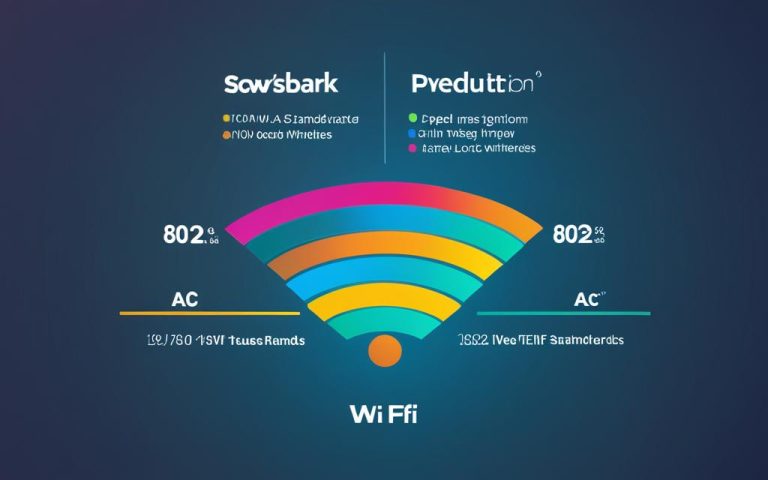In today’s digitally connected world, Wi-Fi networks play a vital role in keeping communities and cities seamlessly connected. However, deploying and optimizing Wi-Fi networks in dense urban environments present unique challenges. Variables such as interference, channel selection, and deployment strategies significantly impact network performance in these areas. To overcome these challenges and ensure superior connectivity, careful planning strategies are essential.
Planning Wi-Fi networks in dense urban environments requires a comprehensive understanding of the specific challenges associated with these areas. Interference management is crucial to mitigate signal disruptions and optimize network performance. Sophisticated channel allocation tactics, leveraging newly available spectrum resources, can create a more favorable Wi-Fi environment in cities. Additionally, clever deployment strategies, such as utilizing rooftops and lampposts as connectivity beacons, help manage traffic and enhance service quality for urban dwellers.
In this article, we will explore the challenges in Wi-Fi network planning for dense urban environments and discuss solutions that optimize network performance. We will also delve into cost-effective strategies for Wi-Fi network deployment in these areas. By employing proper planning strategies and leveraging advanced technologies, cities can bridge the digital divide and provide high-quality broadband connectivity to underserved areas.
Challenges in Wi-Fi Network Planning for Dense Urban Environments
When it comes to Wi-Fi network planning in dense urban environments, there are several key challenges that need to be addressed. Factors such as interference, channel selection, and deployment strategies have a significant impact on the overall performance of the network.
Interference
Interference is one of the most critical concerns in urban environments. With numerous Wi-Fi networks coexisting in close proximity, the likelihood of interference increases substantially. This interference can result in signal degradation, lower throughput, and reduced reliability of the network. Therefore, effective interference management is crucial to ensure a seamless and robust connectivity experience for users.
Channel Selection
Choosing the right frequency channels for Wi-Fi networks in dense urban areas is crucial in minimizing interference and maximizing performance. Traditional 2.4 GHz bands can be overcrowded, leading to significant performance issues. However, the availability of new spectrum resources, such as the 5 GHz band, provides an opportunity for more sophisticated channel allocation tactics. By utilizing these resources effectively, network planners can improve the Wi-Fi environment, mitigating interference and enhancing the overall user experience in urban settings.
Deployment Strategies
In densely populated urban areas, deploying Wi-Fi networks requires careful consideration of various factors. One effective strategy involves utilizing rooftops and lampposts as connectivity beacons. This approach not only helps manage network traffic but also enhances service quality for urban dwellers. By strategically placing network access points in these locations, network coverage can be optimized, ensuring a reliable and consistent connection for users.
Key Takeaways:
Wi-Fi network planning in dense urban environments faces challenges related to interference, channel selection, and deployment strategies.
Effective interference management is crucial to ensure reliable connectivity.
Utilizing newly available spectrum resources and employing sophisticated channel allocation tactics can improve the Wi-Fi environment in cities.
Clever deployment strategies, such as utilizing rooftops and lampposts, help manage network traffic and enhance service quality for urban dwellers.
A well-planned Wi-Fi network in a dense urban environment must overcome the challenges of interference, channel selection, and deployment strategies. By effectively managing interference, leveraging available spectrum resources, and implementing clever deployment tactics, network planners can optimize Wi-Fi performance and deliver reliable connectivity to urban users.
| Challenges | Solutions |
|---|---|
| Interference | Interference management strategies |
| Channel Selection | Sophisticated channel allocation tactics and utilizing newly available spectrum resources |
| Deployment Strategies | Utilizing rooftops and lampposts to optimize network coverage |
Solutions for Optimizing Wi-Fi Network Performance in Dense Urban Environments
When it comes to enhancing Wi-Fi network performance in dense urban environments, there are key strategies that can be implemented to overcome challenges and ensure seamless connectivity. Two crucial areas to focus on are interference management and channel allocation, while also leveraging deployment tactics to enhance service quality. Let’s explore these solutions in detail.
Interference Management
Interference is a common issue in densely populated areas, where multiple networks and devices are competing for limited spectrum resources. To address this challenge, cutting-edge methods for real-time detection, mitigation, and adaptation can effectively minimize interference and optimize Wi-Fi performance.
By continuously monitoring the Wi-Fi environment and dynamically adjusting settings, network administrators can identify and mitigate sources of interference, such as neighboring Wi-Fi networks, Bluetooth devices, and microwave ovens. Machine learning algorithms can analyze patterns and make intelligent decisions to optimize Wi-Fi signal strength and reduce the impact of interference.
Channel Allocation
Flexible tactics for channel allocation are essential in dense urban environments to optimize Wi-Fi network performance. Traditional 2.4 GHz channels are often crowded and susceptible to interference. Hence, utilizing newly available spectrum resources, like the 5 GHz band, can provide wider channel availability and minimize interference.
By implementing dynamic channel assignment algorithms, Wi-Fi networks can automatically select the least congested channels, ensuring better performance and higher throughput. This approach can effectively distribute network traffic and reduce interference, leading to a more reliable and efficient Wi-Fi experience.
Deployment Tactics
Strategic deployment of Wi-Fi access points is another critical factor in optimizing network performance. In dense urban environments, deploying connectivity beacons on rooftops and lampposts can enable better traffic management and improve the quality of service for urban users.
By strategically locating access points in high-density areas, Wi-Fi coverage can be extended to more users, reducing signal congestion and enhancing network capacity. Additionally, deploying access points strategically on elevated structures can help overcome physical obstacles like buildings and ensure better signal propagation.

Implementing these solutions for interference management, channel allocation, and deployment tactics can significantly optimize Wi-Fi network performance in dense urban environments. By proactively addressing these challenges, network administrators can ensure reliable and high-speed connectivity for urban users, enhancing their digital experience.
| Advantages | Challenges | Solutions |
|---|---|---|
| Optimized Wi-Fi performance | Interference from multiple sources | Real-time detection and mitigation |
| Improved network capacity | Channel congestion | Dynamic channel allocation |
| Better user experience | Physical obstacles | Strategic access point deployment |
Cost-effective Strategies for Wi-Fi Network Deployment in Dense Urban Environments
Deploying Wi-Fi networks in dense urban environments can present significant financial and logistical challenges. However, there are cost-effective solutions that can bridge the digital divide and provide broadband connectivity to underserved areas while ensuring the efficient use of resources.
V-band PtMP Systems:
One such solution is the use of V-band Point-to-Multipoint (PtMP) systems. These systems leverage mature technology ecosystems and offer high-performance connectivity with multi-gigabit aggregated access capacity. By utilizing the V-band spectrum, which operates in the 57-66 GHz frequency range, these systems can deliver real broadband connectivity to urban areas, even in dense environments.
Implementing V-band PtMP systems brings several advantages:
- Cost-effectiveness: V-band PtMP systems have a low cost per home passed, making them an economical option for network deployment in densely populated areas.
- Efficient spectrum utilization: The V-band spectrum provides ample capacity to support high-bandwidth applications and services, optimizing the overall network performance.
- Rapid deployment: These systems are quick to deploy, enabling rapid connectivity for new clients without extensive infrastructure costs.
V-band PtMP systems are a versatile and cost-effective solution for Wi-Fi network deployment in dense urban environments. They provide a scalable and efficient way to bridge the digital divide and enhance connectivity in underserved areas.
Fixed Wireless Access Technology:
Another cost-effective strategy for Wi-Fi network deployment in dense urban environments is the utilization of fixed wireless access (FWA) technology. FWA enables instant connection for new clients without the need for extensive cabling or infrastructure upgrades.
Benefits of utilizing FWA technology include:
- Rapid expansion: FWA allows for the quick and efficient expansion of network coverage without the need for significant investments in physical infrastructure.
- Flexibility: FWA technology can be deployed in a variety of locations, including rooftops and building facades, maximizing coverage and adaptability in dense urban environments.
- Low cost per customer: By eliminating the need for costly physical connections, FWA technology significantly reduces the cost of adding new customers to the network.
Conclusion
Effective planning is essential for optimizing Wi-Fi network performance in dense urban environments. By addressing challenges such as interference, channel allocation, and deployment tactics, cities can ensure seamless connectivity and superior Wi-Fi performance.
Interference management plays a crucial role in enhancing Wi-Fi network performance. Real-time detection, mitigation, and adaptation techniques can effectively minimize interference and improve connectivity in crowded urban areas.
Additionally, flexible tactics for channel allocation and leveraging newly available spectrum resources are key in optimizing Wi-Fi networks. These strategies enable better utilization of available bandwidth and enhance the overall performance of Wi-Fi networks in dense urban environments.
Implementing cost-effective solutions and leveraging advanced technologies like fixed wireless access can bridge the digital divide and provide high-quality broadband connectivity to underserved areas. By investing in proper planning and execution, cities can remain at the forefront of technological innovation, keeping their residents seamlessly connected to the digital world.
FAQ
What are the challenges in Wi-Fi network planning for dense urban environments?
Variables such as interference, channel selection, and deployment strategies significantly impact Wi-Fi performance in dense urban environments.
How can I enhance Wi-Fi network performance in dense urban environments?
To enhance Wi-Fi performance in urban settings, it is essential to focus on interference management and utilize sophisticated channel allocation tactics.
What are some solutions for optimizing Wi-Fi network performance in dense urban environments?
Interference management, channel allocation, and deploying connectivity beacons on rooftops and lampposts are effective tactics for improving Wi-Fi network performance in dense urban environments.
How can I deploy Wi-Fi networks in dense urban environments cost-effectively?
Utilizing V-band PtMP systems and fixed wireless access technology can provide real broadband connectivity to underserved areas in a cost-effective manner.
What is the importance of effective planning in Wi-Fi network deployment in dense urban environments?
Effective planning ensures seamless connectivity and superior performance, enabling cities to remain at the forefront of technological innovation.



















